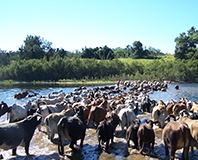Read the latest information on
Foot-and-mouth disease
 Natural disasters are an ever-present concern for those living on the land. Both fire and flood are part of the cycle of extreme weather across the country, while tropical storms and extreme winter weather can also cause havoc in their respective regions.
Natural disasters are an ever-present concern for those living on the land. Both fire and flood are part of the cycle of extreme weather across the country, while tropical storms and extreme winter weather can also cause havoc in their respective regions.
When lives and livelihoods are on the line, decisive action is needed. Once the heat of the moment has passed, however, producers need to fall back on their carefully laid plans to minimize damage. That’s according to Animal Health Australia’s Senior Manager Biosecurity, Dr Rob Barwell.
“When an emergency calls you to drop everything and act, biosecurity is understandably not the first thing on your mind,” said Dr Barwell.
“However the aftermath and recovery phase of a disaster provide ample opportunity for something to go wrong.”
It’s essential that producers have not only disaster management and evacuation plans, but also recovery plans in place, Dr Barwell explained. These plans should take biosecurity and traceability into account wherever practical.
In most cases, a producer will have sufficient warning to evacuate the property prior to the disaster hitting.
“This however raises concerns over where the animals are going to be housed and how they will be fed and watered during the evacuation,” said Dr Barwell.
“Producers should be prepared to bring in feed and water from a trusted source. If other producers are evacuating to the same place, herds should be kept segregated to minimise the risk of disease spread.”
Where practical, any property-to-property movements – defined as an animal moving from one PIC to another – also need to be logged in the NLIS database.
Once the disaster has passed and it’s safe to return to the property, shoring up fences and ensuring the infrastructure is fit-for-purpose should be a major priority.
“Bringing animals back onto the property too soon can do more harm than good if not managed carefully,” said Dr Barwell.
“The same can be said for livestock you weren’t able to evacuate. You need to make sure that you can provide them with shelter, feed and water as soon as possible and guarantee that livestock cannot stray from the property.”
When bringing your livestock and any replacement stock onto the property, the usual procedure for managing introductions should be followed.
“Keep livestock in a yard or smaller paddock, watch for signs of injury or illness and treat as needed. The same goes for feed, bedding or water; ensure that it’s inspected and found to be free of any contaminants.”
Environmental factors may also increase the risk of disease transmission, or drive feral animals and pests onto the property.
“Fire and rising floodwaters can cause feral animals and wildlife to seek food and shelter, which they may find on your property, bringing with them a disease risk to your livestock” said Dr Barwell.
The aftermath of a disaster can also leave carcasses – which need to be disposed of quickly and appropriately – and weed seeds scattered over a large area. Heavy rain and floodwaters can also increase the prevalence of insect pests, creating more vectors for diseases such as bluetongue virus, bovine ephemeral fever and tick fever to spread.
“Increased monitoring of livestock and sprouting weeds is vital in the days and weeks following extreme weather.”
The message for producers is simple: when your wellbeing and that of your livestock is assured, don’t forget your biosecurity plan in your hurry to get your farm operational again.
“These high-stress situations mean something always gets skipped over or missed entirely,” says Dr Barwell.
“But taking the time to consider the disease, pest and weed risk in the wake of a natural disaster should help to ensure that any resulting incursion doesn’t take your situation from bad to worse.”
For more information on assembling a biosecurity plan for your property, visit the Farm Biosecurity website.
Livestock after an emergency (Agriculture Victoria)